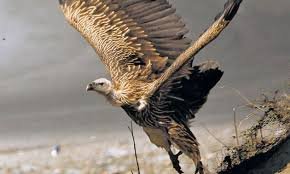Tripura forest dept takes measures to protect vultures

Agartala: As part of its environment conservation efforts, the forest department in Tripura is planning to set up a vulture colony, with abundant food options and a suitable ecosystem, at Khowai district, where the critically endangered bird was recently sighted.
The scavenger bird, which plays a vital role in cleaning up the environment, is suffering a decline in population due to a range of threats, including diclofenac poisoning and habitat destruction.
Niraj Kumar Chanchal, the divisional forest officer (DFO) of Khowai, said 26 vultures were spotted at Kalyanpur area along the river bank and more than 10 at Chebri area.
We are planning to build a restaurant for vultures in Kalyanpur and Chebri so that these birds do not run out of food. We would supply carcasses of animals at their resting and roosting places, Chanchal told PTI.
A survey carried out by former chief wildlife warden Atul Gupta has shown that South Tripura and Sipahijala are the two other districts in the state, where the bird has been sighted in considerable numbers.
"Vultures are an important part of the eco-system.
They maintain a balance between the living and the dead by devouring carcasses. Among the nine species of the birds sighted in the country, white-rumped vulture found in Tripura has been identified as critically endangered, Gupta said.
Chanchal attributed the recent increase in numbers in Tripura to favourable habitat and non-use of diclofenac pills.
"Although India has banned manufacture of diclofenac tablets, a pain killer, for animals, the pills are being manufactured for human use. The farmers often illegally use these tables to treat cattle. Vultures, overdosed with diclofenac are unable to lay eggs.
In Tripura, however, farmers and herders do not use the drug as it is a costly one, he added.
The forest official also observed that big and solitary trees, along a waterbody, are ideal for 'roosting and resting' of the endangered species.
"We have seen vultures roosting on Shimul trees. So, we started a drive to plant as many Shimul trees as possible on the river banks," he said.
The Bombay Nature History Society, in a report, said India once had a total vulture population of 20 million, which, by 2009, dipped to one per cent of the figure.
Prasenjit Biswas, an ornithologist who authored The Last Flight of the Vulture, said human incursion and unavailability of food were the major reasons behind the decline in population.
The Rudra Sagar Lake, its surroundings and the Sipahijala sanctuary, with its large lakes and forests, used to be a favourite haunt of the white-rumped vultures till the late eighties, he rued.
"Human corpses are rarely dumped in the open, while animal carcasses are safely disposed off. This has deprived the vultures of their livelihood," Biswas, who has been studying the movements and traits of vultures for over a decade, added.















































